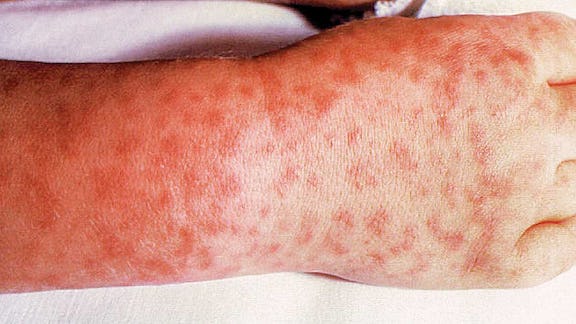
Daniel, a 65-year-old photographer, attends with a history of fevers, headaches and rash. He returned from a work trip documenting national parks in North Carolina, US, 10 days ago.
The fever and headache began four days prior to his attendance. There was associated nausea and a single vomiting episode on day one of his illness. Daniel assumed he had picked up a ‘gastro bug’ on the plane en route home. But upon noticing a blotchy rash on his hands and feet on day four of his illness, he decided to get his local GP’s opinion.
The GP examination findings identify a low-grade fever, mild hypotension and tachycardia. On closer inspection, a blanching non-pruritic rash is seen on Daniel’s hands (see picture) and feet. It has started to move centrally onto his torso and appears petechial in some areas. There is no associated photophobia, neck stiffness or focal neurological deficit. He has a negative Kernig’s sign.
Daniel has no significant medical history and takes no medications.
What is the most likely diagnosis?
Correct!
Rocky Mountain spotted fever (RMSF) is caused by bacterial infection with the organism Rickettsia rickettsii. Ticks carrying R. rickettsii are the most common source of infection. Major Marshall H Wood, a US Army physician, first recognised R. rickettsii infection and described RMSF in 1896.
First identified in the Rocky Mountains, RMSF is most often found in the south-eastern part of the US. It also occurs in parts of Canada, Mexico, Central America and South America. The incubation period is 3-12 days. Early symptoms (within the first four days of illness) include fever; headache; malaise; myalgia; oedema around eyes and on the back of hands; and gastrointestinal symptoms, including nausea, vomiting and anorexia. A rash usually develops within the first five days of the illness. This non-pruritic pink macular rash starts at the peripheries (ankles, forearms and wrists) and moves centrally to the trunk or the palms and soles. Ten per cent of patients with RMSF never develop a rash.
From day five and beyond, more severe signs and symptoms may develop. These include altered mental status, coma, cerebral oedema, respiratory compromise, necrosis requiring amputation and multiorgan system failure. Petechiae are not usually seen until day six and beyond and are an ominous marker of progression to severe disease. Prompt treatment reduces mortality and is usually initiated based on clinical suspicion while laboratory investigations are still pending.
Serology is the mainstay to confirm diagnosis of rickettsial diseases. The indirect fluorescent antibody test is the most reliable method; antibodies typically appear 10-14 days after infection. RMSF can be rapidly fatal if not treated within the first five days of symptoms. Prior to the advent of tetracycline antibiotics, case fatality rates ranged from 20% to 80%.
Tetracyclines are the preferred treatment for adults and children (the risk of stained teeth is outweighed by the improved efficacy of doxycycline). Chloramphenicol is an alternative drug and can be used to treat pregnant women. Tick bite prevention measures, such long-sleeved garments and insect repellent use, are encouraged when visiting at-risk areas.
